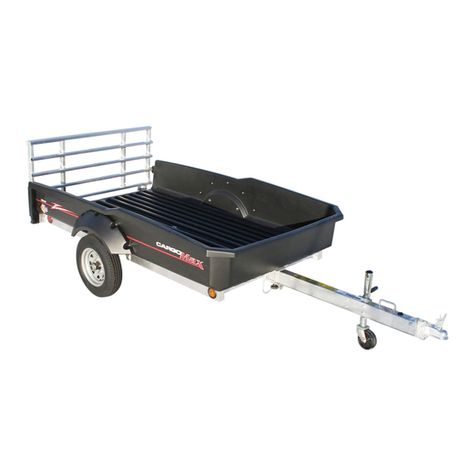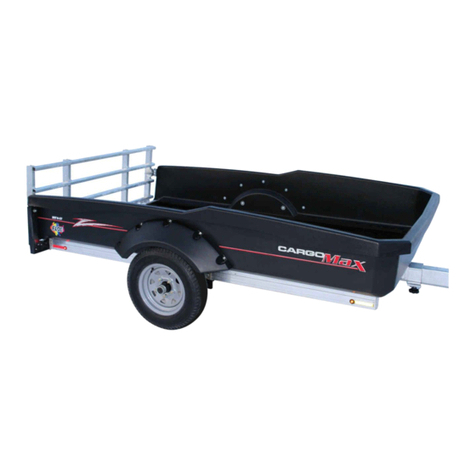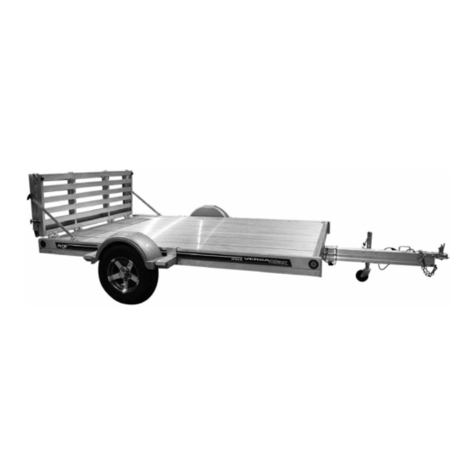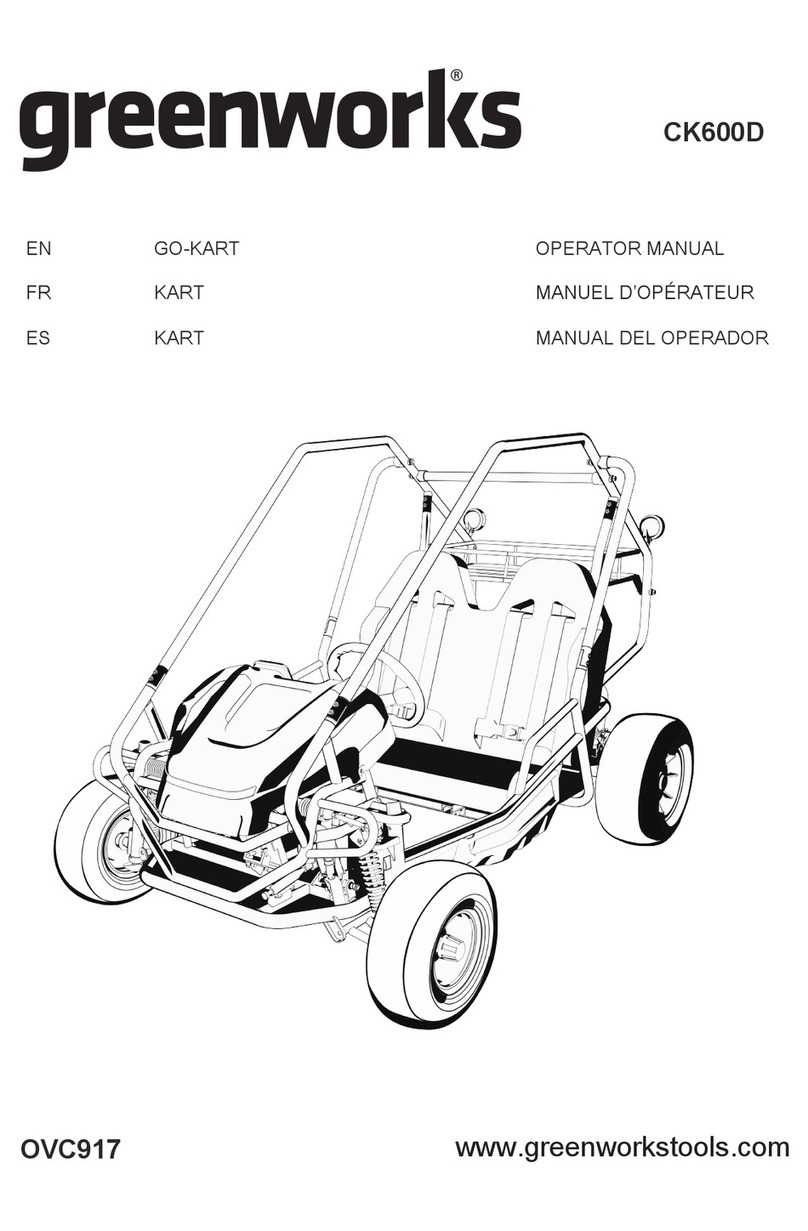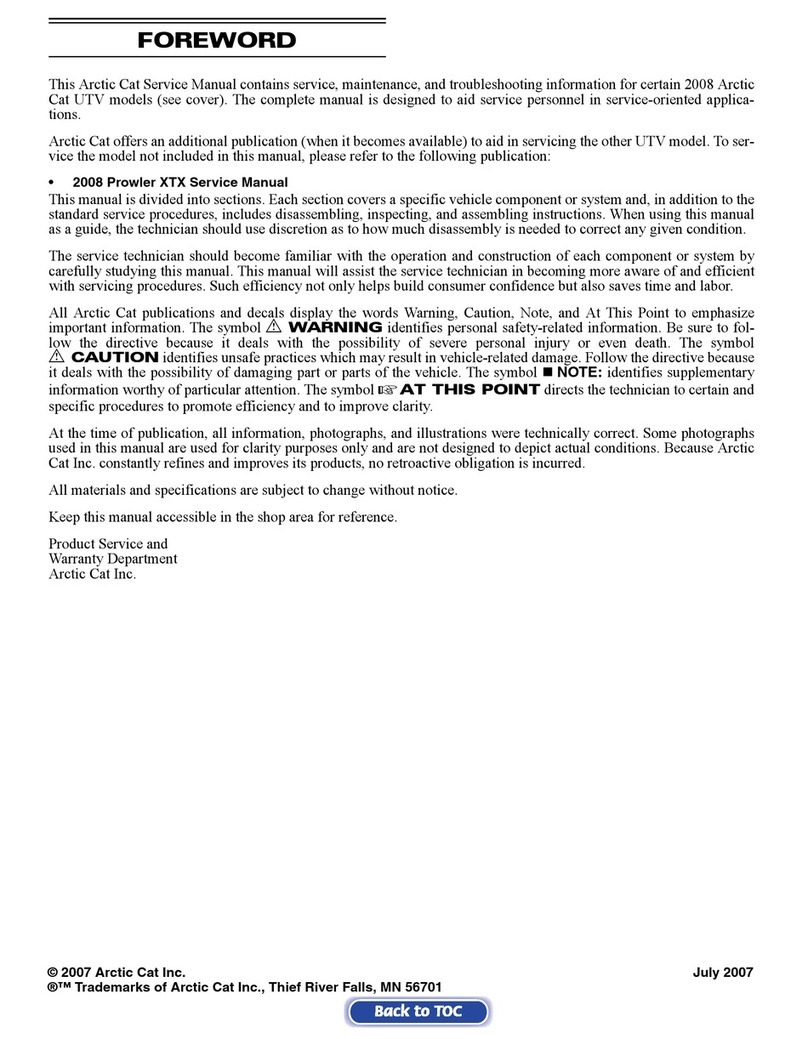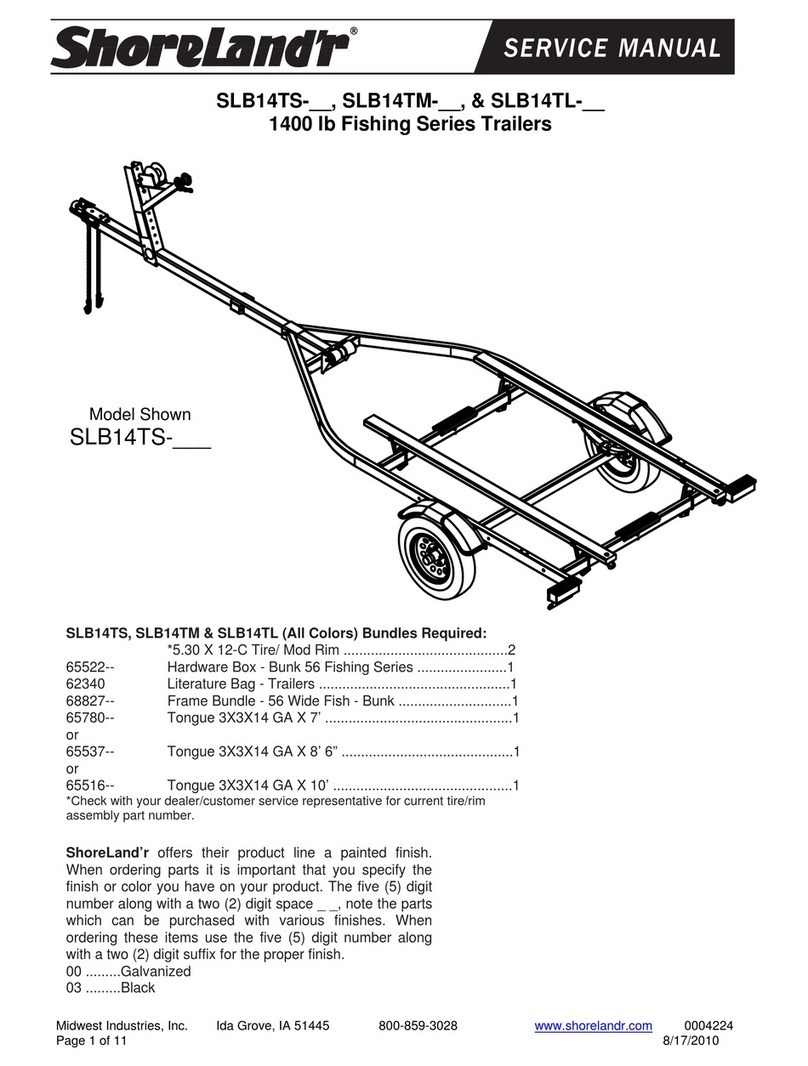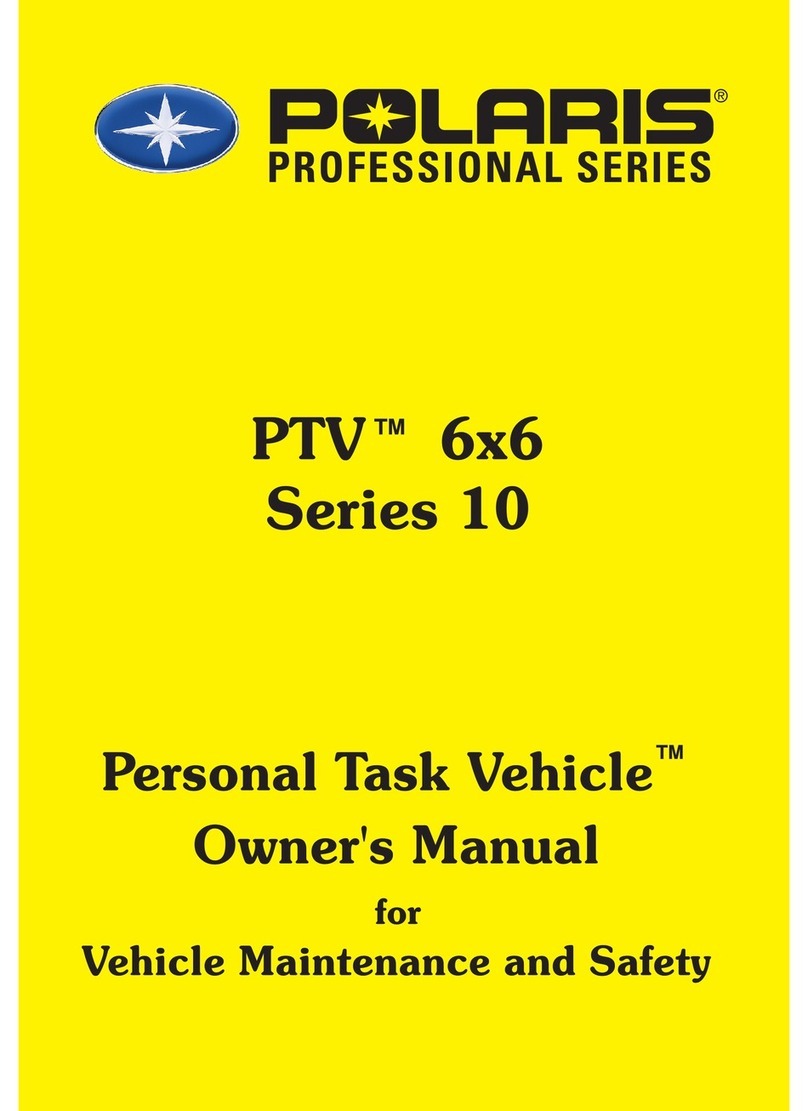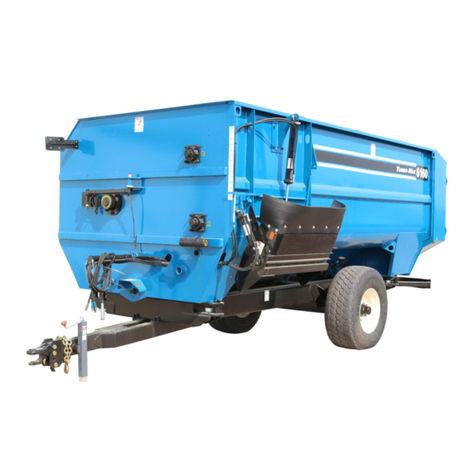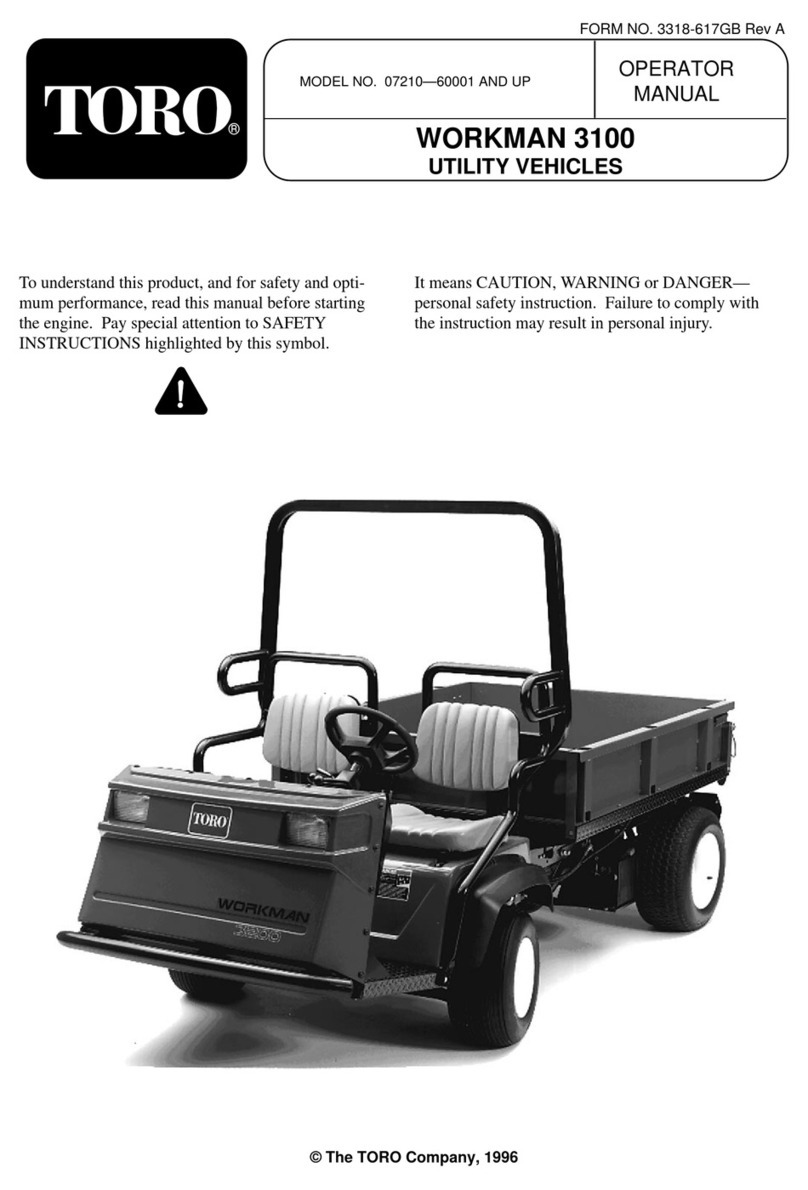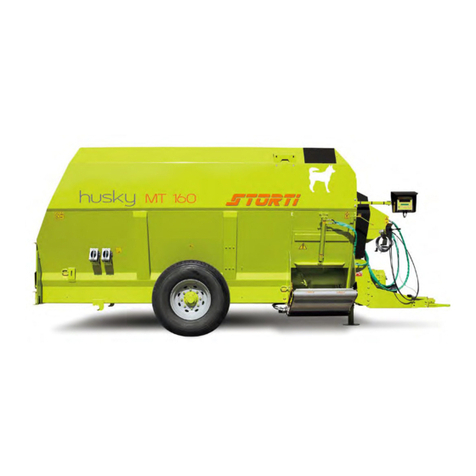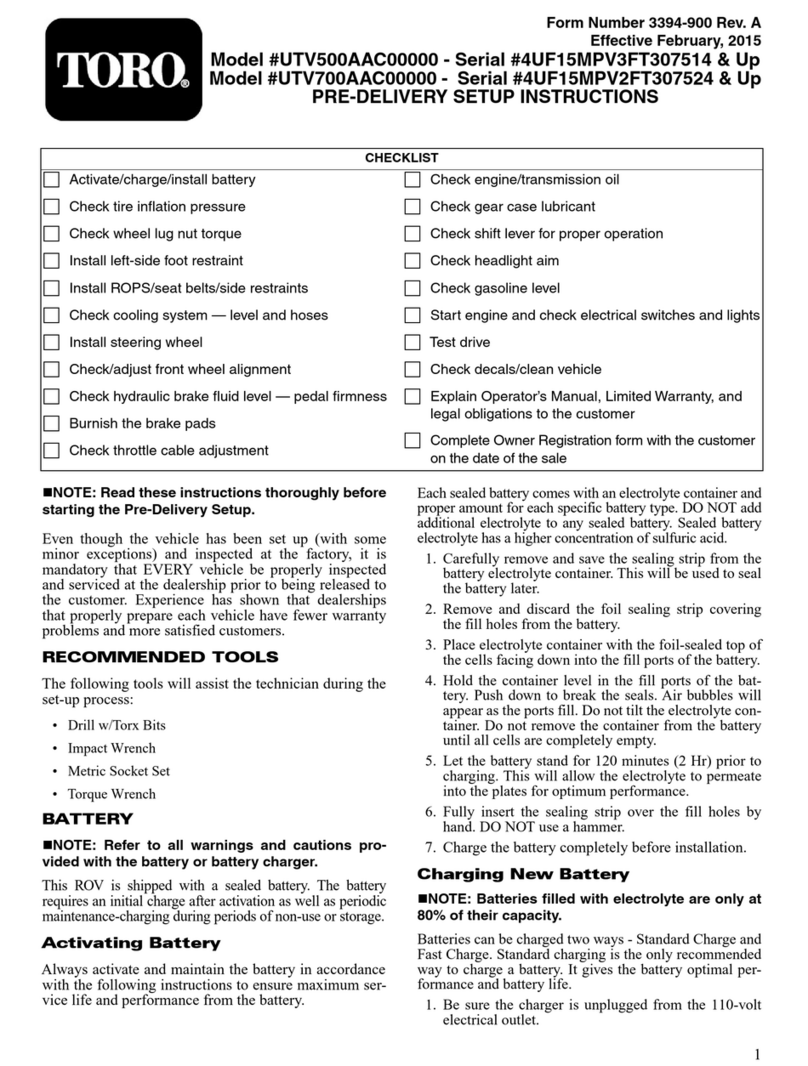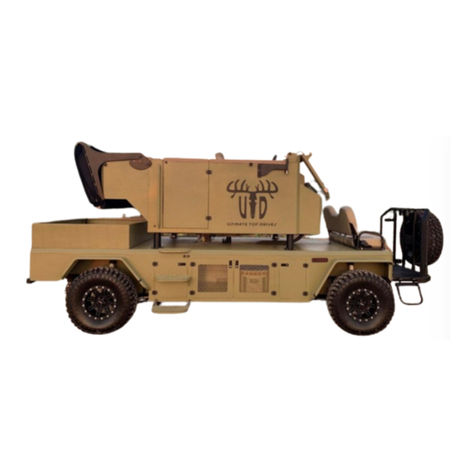Floe 500-95500-00 User manual

Page 1
OWNER’S MANUAL
Featuring FLOE’s exclusive Versa-Track System™
8’
ATV Pro
Tilt Trailer
8’ & 10’
All-Terrain Pro
Utility Trailers
10’ & 12’
Versa-Max
Tilt Trailers

Page 2
Dear Customer,
We appreciate your business and hope you are proud of your new Floe aluminum trailer – a pride that will continue
throughout the years. If you shopped trailers before deciding on the Floe, you probably concluded that our trailer has
numerous features not commonly found on others.
At FLOE INTERNATIONAL, we take great pride in providing the highest quality trailer, with the latest state-of-the-art
features, at an affordable price. Each year we implement improvements to our product lines to ensure that we are on the
“leading edge” and providing the best available trailer.
We are condent your Floe trailer will provide you with years of trouble free trailering, and that if you decide to buy another
trailer, it is because you want another Floe model.
Please take the time to read and understand this owner’s manual before towing your new trailer. The information offered here
will have a direct impact on your safety, the safety of others, and the dependability of your trailer.
Thank you for choosing Floe.
Sincerely,
Wayne Floe
CEO, Floe International
Important Safety Information .............................................. 3
Reporting Safety Defects ............................................... 3
Procedure for Vortex Hub / Spindle...................................... 4
Adding & Changing Grease .......................................... 4
Removing/Remounting .................................................. 5
Axle Assembly ............................................................... 6
Using Your FLOE Trailer...................................................... 7
Hitch Selection ............................................................... 7
Hitch Coupler Adjustment.............................................. 8
Tilt Clamp ...................................................................... 8
Proper Loading & Unloading......................................... 9
Securing Ramp ............................................................... 9
Trailer Safety
Securing the Load ...................................................10-12
Trailer Lighting ................................................................... 12
Changing Tires ............................................................. 13
Care & Maintenance .................................................... 13
Tire Safety ...............................................................14-30
Accessory Installation....................................................32-33
Common Questions and Answers ....................................... 34
Specications Chart ............................................................ 35
Warranty.........................................................................36-38
Contents
Congratulations!

Page 3
Important
Safety Information
It is the owner’s/operator’s responsibility to
check the following items each time before
towing trailer:
• Wheel bearings are properly tightened and oiled.
• Tires are inated to correct pressure.
• Lug nuts on each wheel are tight.
• Trailer is level with tow vehicle and load is
positioned to apply equal weight to all tires.
• Bed locking system (tilt clamp) is properly
secured.
• Ensure safety chains cross each other and open
end of “S” hook faces the trailer.
• Ensure any cables are secure.
• Trailer coupler is properly adjusted and securely
attached to the hitch ball.
• If equipped, brake system is working properly
and breakaway cable is securely attached.
• Trailer electrical connector is properly connected
and all lights are operating correctly.
• Load is secure. Monitor load at regular intervals
once underway.
• Trailer capacity and tongue weight are not
exceeded.
• The width of the trailer in proportion to your
vehicle. Take mental note if trailer width
exceeds that of your towing vehicle and drive
accordingly.
• No structural damage to trailer exists. Do not use
if damaged.
Reporting Safety Defects
If you believe that your trailer has a defect
which could cause a crash or could cause injury
or death, you should immediately inform the
National Highway Trafc Safety Administration
(NHTSA) in addition to notifying FLOE
INTERNATIONAL, INC. at 1-800-336-6337.
If NHTSA receives similar complaints, it may
open an investigation, and if it nds that a safety
defect exists in a group of vehicles, it may
order a recall and remedy campaign. However,
NHTSA cannot become involved in individual
problems between you, your dealer, or FLOE
INTERNATIONAL, INC.
To contact NHTSA, you may either call the Auto
Safety Hotline toll-free at 1-888-327-4236 (TTY:
1-800-424-9153); go to http://www.safercar.gov; or
write to: NHTSA, US Department of Transportation,
1200 New Jersey SE, Washington, D.C. 20590. You
can also obtain other information about motor vehicle
safety from http://www.safercar.gov.
- - - - - - - - - - - - - - IMPORTANT- - - - - - - - - - - - - -
Whether you are using your trailer for
hauling snowmobiles, ATVs or other items,
it is important that you take simple safety
precautions every time you use your trailer.
may result in damage to your trailer or vehicle,
and could cause severe or fatal injury to you
or others.
WARNING
READ THIS INFORMATION BEFORE USING TRAILER!

Page 4
Procedure for
Vortex Hub/Spindle
Simple is best when it comes to Wheel bearing lubrication. Tie Down
has adapted the best features of grease and oil lubrication to develop the
Vortex hub. The Vortex hub bearing lubrication system provides long
term continuous bearing lubrication and ease of service or inspection.
Your trailer is equipped with Vortex hubs/spindles from Tie Down
Engineering. The hubs are pre-grease and assembled at the factory
and should not require any additional adjustments, The Vortex hub
uses tapered roller bearings adjusted to a maximum .006 end play.
The twelve sided castle nut easily maintains this maximum .006 end
play. The conguration requires a minimal amount of end-play that is
factored in at the time of assembly.
Vortex Features:
• Stainless steel wear sleeve on factory assembled spindle/hub units
• Vortex internal through the spindle lubrication system
• Super strong threaded removable grease cap
• Premium grade Lucas Oil Marine grease (100,000 miles)
WHAT MAKES THE VORTEX THE BEST
The rear seal rides on a stainless steel wear sleeve. This provides longer life for the seal as the surface
does not corrode. Corroded or rusted seal surfaces act like sandpaper on the seal causing premature
failure. Vortex lubrication makes changing or adding grease easy with no need to remove the hub. The
threaded grease cap is easy to remove and replace. No more knocking the cap off with a hammer. Lucas
Oil Marine grease is a premium lithium based complex fortied with rust and oxidation inhibitors, high
pressure additives and provides a high degree of moisture resistance and washout properties. These
features allow Tie Down Engineering to offer a 6 year, 100,000 mile limited warranty. See separate
warranty sheet for details.
The Vortex hub/spindle is designed to be a no maintenance hub for 6 years. If you should need to add
grease or remove the hubs for any reason, follow the instructions listed in this owner’s manual.
TO MAINTAIN THE FACTORY WARRANTY, LUCAS OIL MARINE GREASE MUST BE
USED WHEN ADDING OR REPLACING GREASE IN THE VORTEX HUB.
ADDING OR CHANGING GREASE IN YOUR VORTEX HUB
Your Vortex hub/spindle is equipped with the Vortex Lubrication System. Should the hub/bearings
require additional lubrication for any reason, the Vortex lubrication system allows you to do so without
removing the hub or having to re-adjust the bearings. New Lucas Oil Marine grease is pumped into the
zerc tting at the end of the spindle, travels to the rear bearing where the new grease pushes out the old
grease through the rear bearing, center of hub and through the front bearing.
1. Remove the Vortex grease cap, un-screwing in a counter clockwise rotation.
2. Use a standard grease gun loaded with Lucas Oil marine grease to pump grease into the zerc tting
located on the end of the spindle.
TIE DOWN ENGINEERING, Inc.
255 Villanova Drive SW, Atlanta, GA 30336
www.tiedown.com
(404) 344-0000 • Fax (404) 349-0401
© 2010 TIE DOWN ENGINEERING, INC. ALL RIGHTS RESERVED
Vortex Hub
Owners Manual
111010,C1157
Instruction Sheet #08135
101810,B1019
Old
Grease
Out
In
Out
Out
New
Grease
In
Old
Grease
Out
Out
Out
New
Grease
In
101810,B1019
Old
Grease
Out
In
Out
Out
New
Grease
In
Old
Grease
Out
Out
Out
New
Grease
In

Page 5
3. Pump the Lucas Oil Marine grease into
the zerc tting while slowly rotating the
wheel. Grease will ow out of the hub
around the front bearing.
4. When the grease appears to be the new
clean grease, remove the grease gun.
5. Replace the Vortex grease cap. Turn
in a clock-wise rotation until the o-ring
on the cap is in contact with the hub
surface. Turn an additional 1/4 turn to
seal the Vortex cap to the hub. (This is
similar to installing an oil lter in an
automobile)
REMOVING/REMOUNTING FOR THE VORTEX HUB
Removing the Vortex hub for inspection or maintenance should be done in a safe location away from
moving vehicles.
1. Elevate the trailer on level ground using the
manufacturers instructions. Always use jack
stands or other solid supports. Do not rely on
a jack to support the trailer. Block wheels to
keep the trailer from rolling.
2. Remove the tire/wheel assembly.
3. Place a newspaper or cloth on the ground under
the hub to keep any parts from falling onto a
dirty surface.
4. Remove the Vortex grease cap by un-screwing
in a counter clockwise rotation.
5. Remove the cotter pin, castle nut (in a counter
clockwise rotation) and washer.
6. Remove the hub from the spindle. If you have
disc brakes, you will need to remove the brake
caliper to remove the rotor. Follow separate
instructions for disc brake rotor removal.
7. Be careful not to allow the bearings to fall out
of the hub.
8. Clean bearing and cup surfaces.
9. To re-install, coat bearings with Lucas Oil
Marine grease before re-installing.
10. Install bearings and place hub on spindle
in reverse order as listed above. Rotate the
hub while applying approximately 50 ft lbs
of torque to the spindle nut. This translates
into a full hand pressure load with a 12” long
wrench. This “seats” the bearings.
11. Lossen the spindle nut to remove the torque
applied. DO NOT ROTATE THE HUB.
12. Tighten the spindle nut until snug, backing off
only enough to line up the cotter pin with the
hole in the spindle.
13. Bend the cotter pin into place.
14. LOAD HUB WITH LUCAS OIL MARINE
GREASE USING THE INSTRUCTIONS
FOR ADDING OR CHANGING GREASE.
15. Replace the Vortex grease cap. Turn in a
clock-wise rotation until the o-ring on the
cap in contact with the hub surface. Turn an
additional 1/4 turn to seal the Vortex cap to the
hub. (This is similar to installing an oil lter in
an automobile)
16. Replace tire/wheel, torque lug nuts according
to wheel manufacturers instructions.
17. Test hub for proper end play by grabbing
the tire and pulling the tire from side to side.
Readjust if necessary.
18. VERY IMPORTANT: RE-CHECK LUG
NUTS AFTER 25 MILES OF USE.

Page 6
Procedure for
Axle Assembly
1. Place teon insulators on the axle beam mount and line up holes.
Some trailers will have two sets of holes with the front set as the
standard location. The rear set can be used to add tongue weight.
2. Set axle(s) on top of Teon insulators so trailing arm taper is to the
rear of trailer. Start each of the four bolts but do not snug up yet. See
Fig. 1 and Fig. 2
3. Pick a point on the outer edge
of the axle(s) that can be easily
measured to on both sides. Measure
from the center of the coupler to
these points (g. 3). Adjust axles so
these two measurements are equal
to within 1/16”. If mounting more
than one axle, start with the rear
and work forward.
4. Tighten all four bolts to 75 ft/
Ibs. Recheck alignment.
WARNING
Multi axle trailers must be level when towing.
Failure to do so will result in excessive tire
wear and reduced braking power.

Page 7
Using your FLOE trailer
Hitch Selection
When selecting a hitch, there are four important
things to keep in mind:
• Ball size -- All FLOE tilt trailers use 2”
couplers.
• Load capacity -- Load should never exceed the
load capacity of your hitch.
• In-set or out-set hitch -- FLOE recommends an
out-set or receiver-type hitch (See below).
• Hitch Height -- Hitch should be set so the trailer
is level.
- - - - - - - - - - - - - - IMPORTANT- - - - - - - - - - - - - -
Pulling a trailer that is not level could greatly
an uncomfortable and dangerous situation
while towing. It could also create excessive or
negative tongue weight which can cause either
tongue or axle damage.
When connecting your trailer to the towing
vehicle, it is important that your hitch coupler
is adjusted with the correct amount of force
for both smooth and safe trailer performance.
A loose connection may cause the coupler to
disconnect or to rattle. An over-tight coupler
This can also transmit unnecessary vibration to
your towing vehicle.
WARNING
When turning or backing up, the towing vehicle
operator must exercise good judgement.
The manufacturer will not be responsible for
damage that results from the tongue or trailer
coming in contact with towing vehicle!
CAUTION
These illustrations show that
a trailer’s turning radius is
signicantly reduced when
towed by vehicles equipped
with an “in-set” hitch. To
reduce the risk of damage, we
recommend the use of an
“out-set” or “receiver-type”
hitch.
Out-set Hitch (Recommended) In-set Hitch (NOT Recommended)

Page 8
Using your FLOE trailer
Hitch Coupler Adjustment
All FLOE models have a lever lock hitch coupler. On the lever lock coupler, the amount of locking force
can be adjusted to the diameter of the hitch ball. To change the amount of locking force against the hitch
ball:
1. Release the hitch coupler locking lever (to its straight up position).
2. Locate the adjustment nut on the bottom of the hitch coupler.
3. Rotate the nut on the threaded shaft counter clockwise to decrease tightness, or clockwise to increase
tightness.
4. Re-mount the trailer coupler on the hitch ball.
5. Push down the hitch coupler locking lever to its original locking position.
6. Repeat steps 1 through 5 until a snug t is obtained. (If you are unfamiliar with how tight to adjust
your coupler, consult your FLOE dealer.)
Using your FLOE trailer
Tilt Clamp
The Floe tilt clamp eliminates the hassle and rattle
of a hitch pin design. To tilt, simply loosen T-
bolt, remove the safety cotter pin, and slide clamp
forward. Slide back on, replace cotter pin, and
tighten when nished loading or unloading.
1. Loosen Knob on underside of tilt clamp.
2. Remove safety cotter pin.
3. Slide clamp forward.
4. To tilt trailer bed, either lift up on front of
trailer, or push down on rear of trailer.
5. Load trailer (see “Proper Loading and
Unloading” on page 7)
6. Tilt trailer back to horizontal position by lifting
up on rear of trailer, or pushing down on front of
trailer.
7. Slide tilt clamp back to original position,
replace cotter pin and tighten Knob.
8. Secure your load before towing. (see pages 7-9)
Failure to tighten tilt clamp and secure safety
pin before towing trailer could cause the trailer
to tilt while in transit.
WARNING
Note: If your trailer does not stay in the tilted position:
1. The tongue mounting bolt may not be tightened to
optimal tension.
2. A tilt-assist shock assembly is available as an accessory
for your FLOE tilt trailer. See page 18.
Slide clamp forward to tilt
Trailer in tilted position
Safety-pin Knob

Page 9
Using your FLOE trailer
Proper Loading & Unloading
Loads should be placed on the trailer so that
proper weight is applied to the tongue. Increase
or decrease the tongue weight by moving the
load forward or backward. When possible, loads
should also be placed to distribute equal weight to
all tires to prevent poor towing, axle damage, and
unequal or premature tire wear. See the diagrams
below for suggested load placement and tongue
weight. Unlike many trailers, the advanced design
of your FLOE trailer requires very little tongue
weight in order to minimize sway and to track
smoothly behind your tow vehicle.
The illustrations below are for typical placement
of snowmobiles. Use this information and
common sense for placing other loads as well.
Tongue weights are not strict maximums or
minimums, they are recommended ranges that
work well for the illustrated loads.
Failure to follow the steps below when loading
or unloading could result in damage to your
trailer, tow vehicle, snowmobile, and/or cause
possible severe or fatal injury to yourself and
others.
CAUTION
1. Never load or unload your trailer unless it is
properly connected to your tow vehicle.
2. It is imperative that your tow vehicle and trailer
are parked on level, even ground. Loading while
parked on an incline or uneven ground could
cause your trailer bumper to be at an improper
angle. This could catch your ski and cause
damage to your trailer, snowmobile and/or cause
severe or fatal injury.
3. Never load at speeds greater than 5 mph.
4. Ensure the trailer is fully tilted and that it will
stay in the tilted position until you have driven
on to it.
5. After loading, make sure the tilt clamp is secure
and will not work itself loose while being
towed. Make sure the safety pin is attached.
6. Always test your footing before walking on the
trailer’s deck. It may get very slippery in cold,
wet and snowy weather.
10’ & 12’ Tilt
Tongue Wt. 45-100 lbs
Ideal: 70 lbs.
Utility
Tongue Wt. 25-80 lbs
Ideal: 50 lbs.
Using your FLOE trailer
Securing Ramp
Be sure that you tighten the crank handle rmly in
place each time you travel and each time the ramp
is put into it’s storage position.
the crank handle may result in the trailer ramp
becoming loose and falling out.
WARNING
Crank Handle
Be sure to securely
tighten crank handle
before each trip.

Page 10
Safety
Securing The Load
- - - - - - - - - - - - - - IMPORTANT- - - - - - - - - - - - - -
Although your FLOE trailer is equipped
with certain load securing features, it is the
responsibility of the operator to decide what is
necessary to properly secure the load for the
travel conditions.
Failure to read the Versa-Lock use instructions
prior to using it could result in severe damage
to the cargo it is meant to hold, cause a road
hazard, or even death.
WARNING
VERSA-LOCK ASSEMBLY INSTRUCTIONS
1. Slide spacer tube and handle over threaded
rod. Thread 1/2” nut down to handle and
tighten so handle is perpendicular (90º) to tie
down lock. Torque to 60 ft. lbs. See Fig. 4
2. Insert threaded rod through tie down bar
from the bottom. The tie down lock and
handle assembly should be on the bottom
(at) side of bar. Slide the plastic disc over
rod. Apply a liberal amount of anti-seize
lubricant onto the threaded rod. Screw the
lever assembly onto the rod until 1” of thread
is sticking out the top of lever assembly. See
Fig. 5.
3. Before using the Versa-Lock to secure a
load, read and understand the instructions on
how to use it.
VERSA-LOCK USE INSTRUCTIONS
1. With the snowmobile loaded on the trailer, place the tie-down bar on the skis, insert the tie-down lock
into the Versa-Track™ on the trailer and turn handle 90º. See Fig. 6. The handle should be parallel (in
line) with Versa-Track and directly below the lever assembly. Ensure tie-down lock is properly seated
as shown in Fig. 7, by lifting handle and moving from side to side until lock is completely square
across track.
CONTINUED NEXT PAGE
Lever Assembly
Plastic
Disc
Tie Down Bar
Handle
Tie Down Lock
Threaded Rod
1/2” 20 Nut
Handle
Tie Down Lock
Spacer Tube
FIG. 4
FIG. 5
Insert tie down
lock and turn 90º
FIG. 6 IncorrectCorrect
Versa-Track
Tie down lock
IncorrectCorrect FIG. 7
- - - - IMPORTANT - - - -
Anti-seize lubricant
MUST be applied on
the threaded rod of
the Versa-Lock when
time and annually or
as needed to provide
peak performance.

Page 11
As with any tie-down system, the ultimate
responsibility for ensuring that the load is
adequately secured lies with the driver. At
a minimum, FLOE recommends the use of a
properly tensioned tie-down bar and a means
to secure the rear of the snowmobile (as
shown in Figs. 11 & 12). You may choose to
do more or less, based on road conditions and
when determining load-securing measures,
and periodically check your load to ensure
security is maintained.
CAUTION
CONTINUED FROM PREVIOUS PAGE
2. Crank the lever assembly down until it is a
maximum of 3/8” from the plastic disc when the
tie-down bar is sitting on the skis. See Fig. 8.
3. To clamp tie down bar in place, pull up on
handle and move side to side to make sure tie
down lock is seated properly in Versa-Track.
See Fig. 7. Use your other hand to push down
on lever assembly while still pulling up on
handle. Pulling the handle up keeps the tie-down
assembly in vertical position and allows it to
clamp down much easier. See Fig. 9. If more
or less holding pressure is desired, simply lift
lever up and turn clockwise to tighten or counter
clockwise to loosen.
4. With the Versa-Lock in the clamped position,
insert the safety snap pin to hold the lever
assembly down. See Fig. 10. A padlock (not
included) may be used instead of the snap pin
for added security. Failure to insert the safety
snap pin or padlock will result in the load
becoming unsecured.
5. A recommended Quick Loop and strap for rear
tie-down is shown in Fig. 11. Fig 12 shows a
properly installed Versa-Lock with tie-down bar.
Note: If the Versa-Lock is used on a different
snowmobile, it may need to be adjusted up or
down for varying ski heights.
Safety
Securing The Load
Lever Assembly
Plastic Disc
3/8” Max.
Handle
FIG. 8 FIG. 9
FIG. 10
FIG. 11
FIG. 12

Page 12
Safety
Securing The Load
Safety
Trailer Lighting System
Special emphasis has been placed on the design of
your FLOE trailer’s lighting and wiring system to
ensure that it is long-lasting and maintenance-free.
FLOE uses high quality lights that are commonly
found on commercial over-the-road trailers.
SIDE MARKER LIGHTS (Amber and Red)
• Shock-mounted (on replaceable rubber
grommets)
• Waterproof sealed units (for longer life)
• Easy to replace
• Small enough to carry spares
REAR TAIL/BRAKE/TURN SIGNAL LIGHTS
• Standard size
• Easy to replace and to carry spares
REAR ID MARKER LIGHTS, FRONT/REAR
CLEARANCE LIGHTS
• Standard size
• Easy to replace and to carry spares
TONGUE CONNECTOR AND HARNESS
• Electrical connector has a molded harness for
long lasting durability. Your trailer is equipped
with a plug-in receptacle to keep the electrical
connector protected when not in use.
• Tongue portion of wiring harness can be replaced
without having to splice or replace the remaining
wiring harness.
• Wire harness is run through the trailer frame to
keep it protected from the elements.
• To ensure trouble-free use, periodically inspect
all connections for tight, corrosion-free contact
and apply an electrical grease as necessary to
prevent future corrosion.
The wiring diagram provides the information
needed for wiring the towing vehicle harness/
connector. It is important that the proper
connections be made and that the system is tested
before using your trailer.
White - Grounds all lights
Brown - Front & rear marker lights
3 light ID bar & tail lights
Yellow - Left turn / brakes
Green - Right turn / brakes
QUICK-LOOP™ INSTALLATION
Lubricate the threads of the bolt with Anti-seize.
Insert the Quick Looop assembly into the Versa-Track. Rotate
the cam until the insert catches in the Versa-Track. While
pulling up on the Quick Loop, tighten until insert stays engaged
with slot. Slide the Quick Loop to the desired location and
nish tightening the bolt. Quick Loops should be installed so
that the pull is as close to perpendicular as possible.

Page 13
Safety
Changing Tires
CHANGING TIRES
1. Start all lug nuts by hand to prevent cross-
threading and to ensure proper nut-to-rim seal.
2. Tighten bolts in the sequence detailed below in
stages, rst tighten to 25 ft./lbs. then 60 ft/lbs.
and nally 80 ft./lbs.
3. Inate tires to proper PSI as noted on the
sidewall of the tire.
4
2 5
3
1
Safety
Care & Maintenance
- - - - - - - - - - - - - - IMPORTANT- - - - - - - - - - - - - -
It is very important to read and follow these maintenance procedures to help avoid trailer failure.
Any trailer failure resulting from improper maintenance may void your warranty.
COMPONENT CARE & MAINTENANCE AVOID
Wheel Hubs a) Adjust wheel bearings within the rst 100 miles and every
2,000 miles, or annually thereafter, whichever comes rst.
(Inspect bearings, seals, and races - replace if worn.) To
check for wear, jack up the trailer and pull on each wheel to
see if there is any in and out play or “slop.” The Turbo-
Lube oil bath system eliminates the need for greasing or
packing the bearings.
a) Getting sand in hubs or bearings.
b) Neglecting to check the oil levels in
the hubs’ transparent caps.
c) Exceeding 40,000 miles without
changing the oil in the hubs.
Axle a) Powder Coated - clear road salt off after using trailer to
prolong life of axle.
Tires a) Keep tires properly inated.
b) Inspect periodically. (Replace when necessary)
a) Leaving loaded for long periods
a) Driving with worn tires.
Aluminum
Surfaces
a) Rinse periodically with water, particularly if driven on
“salted” roadways.
b) Remove grease, oil and dirt by scrubbing with soft bristle
brush and mild detergent. Rinse with clean water.
a) Harsh, abrasive cleaners.
b) Bolting or hard-mounting dissimilar
metals to aluminum surfaces.
Decking Surface a) Rinse periodically to remove surface dirt especially when
driving on “salted” roadways.
a) Using harsh chemicals or solvents
Electrical System
Connector
a) Periodically check for build-up of oxidation or corrosion
and clean when necessary. Use electrical grease in all wire
and bulb connections to help prevent corrosion.
- - - - - - - - - - - - - - NOTE- - - - - - - - - - - - - -
The aluminum structure of your trailer is lightweight, super strong, and never needs painting. This
structure contains corrosion-resistant alloys that are specially tempered and heat-treated for added
strength and durability.

Page 14
Safety
Tire Safety
Studies of tire safety show that maintaining proper
tire pressure, observing tire and vehicle load lim-
its (not carrying more weight in your vehicle than
your tires or vehicle can safely handle), avoiding
road hazards, and inspecting tires for cuts, slashes,
and other irregularities are the most important
things you can do to avoid tire failure, such as
tread separation or blowout and at tires. These
actions, along with other care and maintenance
activities, can also:
• Improve vehicle handling
• Help protect you and others from avoidable
breakdowns and accidents
• Improve fuel economy
• Increase the life of your tires.
This booklet presents a comprehensive overview
of tire safety, including information on the follow-
ing topics:
• Basic tire maintenance
• Uniform Tire Quality Grading System
• Fundamental characteristics of tires
• Tire safety tips.
BASIC TIRE MAINTENANCE
Properly maintained tires improve the steering,
stopping, traction, and load-carrying capability of
your vehicle. Underinated tires and overloaded
vehicles are a major cause of tire failure. There-
fore, as mentioned above, to avoid at tires and
other types of tire failure, you should maintain
proper tire pressure, observe tire and vehicle load
limits, avoid road hazards, and regularly inspect
your tires.
- - - - - - - - - - - - - - NOTE- - - - - - - - - - - - - -
Use the following information to make tire safety a regular part of your vehicle maintenance
routine. Recognize that the time you spend is minimal compared with the inconvenience and
UNDERSTANDING TIRE PRESSURE
AND LOAD LIMITS
Tire ination pressure is the level of air in the tire
that provides it with load-carrying capacity and
affects the overall performance of the vehicle. The
tire ination pressure is a number that indicates
the amount of air pressure– measured in pounds
per square inch (psi)–a tire requires to be properly
inated. (You will also nd this number on the
vehicle information placard expressed in kilo-
pascals (kPa), which is the metric measure used
internationally.)
Manufacturers of passenger vehicles and light
trucks determine this number based on the vehi-
cle’s design load limit, that is, the greatest amount
of weight a vehicle can safely carry and the ve-
hicle’s tire size.The proper tire pressure for your
vehicle is referred to as the “recommended cold
ination pressure.” (As you will read below, it is
difcult to obtain the recommended tire pressure
if your tires are not cold.)
WARNING
Lug nuts must be re-torqued to 80 ft/lbs after

Page 15
CHECKING TIRE PRESSURE
It is important to check your vehicle’s tire pres-
sure at least once a month for the following
reasons:
* Most tires may naturally lose air over time.
* Tires can lose air suddenly if you drive over
a pothole or other object or if you strike the curb
when parking.
* With radial tires, it is usually not possible to
determine underination by visual inspection.
For convenience, purchase a tire pressure gauge
to keep in your vehicle. Gauges can be purchased
at tire dealerships, auto supply stores, and other
retail outlets.
The recommended tire ination pressure that ve-
hicle manufacturers provide reects the proper psi
when a tire is cold. The term cold does not relate
to the outside temperature. Rather, a cold tire is
one that has not been driven on for at least three
hours. When you drive, your tires get warmer,
causing the air pressure within them to increase.
Therefore, to get an accurate tire pressure reading,
you must measure tire pressure when the tires are
cold or compensate for the extra pressure in warm
tires.
MAINTAINING PROPER TIRE PRESSURE
* Step 1: Locate the recommended tire pressure
on the vehicle’s tire information placard, certica-
tion label, or in the owner’s manual.
* Step 2: Record the tire pressure of all tires.
* Step 3: If the tire pressure is too high in any of
the tires, slowly release air by gently pressing on
the tire valve stem with the edge of your tire gauge
until you get to the correct pressure.
* Step 4: If the tire pressure is too low, note the
difference between the measured tire pressure and
the correct tire pressure. These “missing” pounds of
pressure are what you will need to add.
* Step 5: At a service station, add the missing
pounds of air pressure to each tire that is underin-
ated.
* Step 6: Check all the tires to make sure they
have the same air pressure (except in cases in
which the front and rear tires are supposed to have
different amounts of pressure).
If you have been driving your vehicle and think that
a tire is underinated, ll it to the recommended
cold ination pressure indicated on your vehicle’s
tire information placard or certication label. While
your tire may still be slightly underinated due to
the extra pounds of pressure in the warm tire, it is
safer to drive with air pressure that is slightly lower
than the vehicle manufacturer’s recommended cold
ination pressure than to drive with a signicantly
underinated tire. Since this is a temporary x,
don’t forget to recheck and adjust the tire’s pressure
when you can obtain a cold reading.
Safety
Tire Safety
Because tires are designed to be used on more
than one type of vehicle, tire manufacturers list
the “maximum permissible ination pressure”
on the tire sidewall. This number is the greatest
amount of air pressure that should ever be put in
the tire under normal driving conditions.

Page 16
Safety
Tire Safety
TIRE TREAD
The tire tread provides the gripping action and
traction that prevent your vehicle from slipping or
sliding, especially when the road is wet or icy. In
general, tires are not safe and should be replaced
when the tread is worn down to 1/16 of an inch.
Tires have built-in treadwear indicators that let
you know when it is time to replace your tires.
These indicators are raised sections spaced inter-
mittently in the bottom of the tread grooves. When
they appear “even” with the outside of the tread,
it is time to replace your tires. Another method
for checking tread depth is to place a penny in the
tread with Lincoln’s head upside down and facing
you. If you can see the top of Lincoln’s head, you
are ready for new tires.
TIRE BALANCE AND WHEEL ALIGNMENT
To avoid vibration or shaking of the vehicle when
a tire rotates, the tire must be properly balanced.
This balance is achieved by positioning weights
on the wheel to counterbalance heavy spots on the
wheel-and-tire assembly. A wheel alignment ad-
justs the angles of the wheels so that they are po-
sitioned correctly relative to the vehicle’s frame.
This adjustment maximizes the life of your tires
and prevents your car from veering to the right or
left when driving on a straight, level road. These
adjustments require special equipment and should
be performed by a qualied technician.
TIRE REPAIR
The proper repair of a punctured tire requires a
plug for the hole and a patch for the area inside
the tire that surrounds the puncture hole. Punc-
tures through the tread can be repaired if they are
not too large, but punctures to the sidewall should
not be repaired. Tires must be removed from the
rim to be properly inspected before being plugged
and patched.
TIRE ROTATION
Rotating tires from front to back and from side to
side can reduce irregular wear (for vehicles that
have tires that are all the same size). Look in your
owner’s manual for information on how frequent-
ly the tires on your vehicle should be rotated and
the best pattern for rotation.
A Tire Rotation Example
For maximum mileage, rotate your tires every
5,000 miles. Follow correct rotation patterns.
TIRE SIZE
To maintain tire safety, purchase new tires that
are the same size as the vehicle’s original tires or
another size recommended by the manufacturer.
Look at the tire information placard, the owner’s
manual, or the sidewall of the tire you are replac-
ing to nd this information. If you have any doubt
about the correct size to choose, consult with the
tire dealer.

Page 17
UNIFORM TIRE QUALITY GRADING
SYSTEM (UTQGS)
To help consumers compare a passenger car tire’s
treadwear rate, traction performance, and temper-
ature resistance, the federal government requires
tire manufacturers to grade tires in these three
areas. This grading system, known as the Uniform
Tire Quality Grading System, provides guidelines
for making relative comparisons when purchas-
ing new tires. You also can use this information
to inquire about the quality of tires placed on new
vehicles.
Although this rating system is very helpful when
buying new tires, it is not a safety rating or guar-
antee of how well a tire will perform or how long
it will last. Other factors such as personal driv-
ing style, type of car, quality of the roads, and tire
maintenance habits have a signicant inuence on
your tire’s performance and longevity.
Treadwear grades are an indication of a tire’s rela-
tive wear rate. The higher the treadwear number is,
the longer it should take for the tread to wear down.
For example, a tire grade of 400 should wear twice
as long as a tire grade of 200.
Traction grades are an indication of a tire’s abil-
ity to stop on wet pavement. A higher graded tire
should allow you to stop your car on wet roads in
a shorter distance than a tire with a lower grade.
Traction is graded from highest to lowest as “AA”,
“A”, “B”, and “C”.
Temperature grades are an indication of a tire’s
resistance to heat. Sustained high temperature (for
example, driving long distances in hot weather),
can cause a tire to deteriorate, leading to blowouts
and tread separation. From highest to lowest, a
tire’s resistance to heat is graded as “A”, “B”, or
“C”.
Safety
Tire Safety
Information on Passenger Vehicle Tires
Please refer to the diagram below.
TIRE FUNDAMENTALS
Federal law requires tire manufacturers to place
standardized information on the sidewall of all
tires. This information identies and describes the
fundamental characteristics of the tire and also
provides a tire identication number for safety
standard certication and in case of a recall.
P
The “P” indicates the tire is for passenger vehicles.
NEXT NUMBER
This three-digit number gives the width in mil-
limeters of the tire from sidewall edge to sidewall
edge. In general, the larger the number, the wider
the tire.

Page 18
Safety
Tire Safety
SPEED RATING
The speed rating denotes the speed at which a tire
is designed to be driven for extended periods of
time. The ratings range from 99 miles per hour
(mph) to 186 mph. These ratings are listed below.
Note: You may not nd this information on all
tires because it is not required by law.
LETTER SPEED LETTER
SPEED
Q 99 mph H 130 mph
R 106 mph V 149 mph
S 112 mph W 168* mph
T 118 mph Y 186* mph
U 124 mph
* For tires with a maximum speed capability over 149 mph,
tire manufacturers sometimes use the letters ZR. For those
with a maximum speed capability over 186 mph, tire manu-
facturers always use the letters ZR.
U.S. DOT TIRE IDENTIFICATION NUMBER
This begins with the letters “DOT” and indicates
that the tire meets all federal standards. The next
two numbers or letters are the plant code where
it was manufactured, and the last four numbers
represent the week and year the tire was built.
For example, the numbers 3197 means the 31st
week of 1997. The other numbers are marketing
codes used at the manufacturer’s discretion. This
information is used to contact consumers if a tire
defect requires a recall.
NEXT NUMBER
This two-digit number, known as the aspect ratio,
gives the tire’s ratio of height to width. Numbers
of 70 or lower indicate a short sidewall for im-
proved steering response and better overall han-
dling on dry pavement.
R
The “R” stands for radial. Radial ply construction
of tires has been the industry standard for the past
20 years.
NEXT NUMBER
This two-digit number is the wheel or rim diam-
eter in inches. If you change your wheel size, you
will have to purchase new tires to match the new
wheel diameter.
NEXT NUMBER
This two- or three-digit number is the tire’s load
index. It is a measurement of how much weight
each tire can support. You may nd this informa-
tion in your owner’s manual. If not, contact a local
tire dealer. Note: You may not nd this information
on all tires because it is not required by law.
M+S
The “M+S” or “M/S” indicates that the tire has
some mud and snow capability. Most radial tires
have these markings; hence, they have some mud
and snow capability.

Page 19
TIRE PLY COMPOSITION AND MATERIALS USED
The number of plies indicates the number of lay-
ers of rubber-coated fabric in the tire. In general,
the greater the number of plies, the more weight
a tire can support. Tire manufacturers also must
indicate the materials in the tire, which include
steel, nylon, polyester, and others.
MAXIMUM LOAD RATING
This number indicates the maximum load in kilo-
grams and pounds that can be carried by the tire.
MAXIMUM PERMISSIBLE INFLATION PRESSURE
This number is the greatest amount of air pressure
that should ever be put in the tire under normal
driving conditions.
Safety
Tire Safety
UTQGS INFORMATION
TREADWEAR NUMBER
This number indicates the tire’s wear rate. The
higher the treadwear number is, the longer it
should take for the tread to wear down. For ex-
ample, a tire graded 400 should last twice as long
as a tire graded 200.
TRACTION LETTER
This letter indicates a tire’s ability to stop on wet
pavement. A higher graded tire should allow you
to stop your car on wet roads in a shorter distance
than a tire with a lower grade. Traction is graded
from highest to lowest as “AA”,”A”, “B”, and
“C”.
TEMPERATURE LETTER
This letter indicates a tire’s resistance to heat.
The temperature grade is for a tire that is inated
properly and not overloaded. Excessive speed,
underination or excessive loading, either sepa-
rately or in combination, can cause heat build-up
and possible tire failure. From highest to lowest,
a tire’s resistance to heat is graded as “A”, “B”, or
“C”.

Page 20
Safety
Tire Safety
Tire Safety Information
1. TIRE SAFETY INFORMATION
This portion of the User’s Manual contains tire safety information as required by 49 CFR 575.6.
Section 2.1 contains “Steps for Determining Correct Load Limit - Trailer”.
Section 2.2 contains “Steps for Determining Correct Load Limit –Tow Vehicle”.
Section 2.3 contains a Glossary of Tire Terminology, including “cold inflation pressure”, “maximum inflation
pressure”, “recommended inflation pressure”, and other non-technical terms.
Section 2.4 contains information from the NHTSA brochure entitled “Tire Safety –Everything Rides On It”.
This brochure This brochure, as well as the preceding subsections, describes the following items;
Tire labeling, including a description and explanation of each marking on the tires, and information
about the DOT Tire Identification Number (TIN).
Recommended tire inflation pressure, including a description and explanation of:
A. Cold inflation pressure.
B. Vehicle Placard and location on the vehicle.
C. Adverse safety consequences of under inflation (including tire failure).
D. Measuring and adjusting air pressure for proper inflation.
Tire Care, including maintenance and safety practices.
Vehicle load limits, including a description and explanation of the following items:
A. Locating and understanding the load limit information, total load capacity, and cargo capacity.
B. Calculating total and cargo capacities with varying seating configurations including quantitative examples
showing / illustrating how the vehicles cargo and luggage capacity decreases as combined number and size
of occupants’ increases. This item is also discussed in Section 3.
C. Determining compatibility of tire and vehicle load capabilities.
D. Adverse safety consequences of overloading on handling and stopping on tires.
1.1. STEPS FOR DETERMINING CORRECT LOAD LIMIT –TRAILER
Determining the load limits of a trailer includes more than understanding the load limits of the tires alone. On all trailers
there is a Federal certification/VIN label that is located on the forward half of the left (road) side of the unit. This
certification/VIN label will indicate the trailer’s Gross Vehicle Weight Rating (GVWR). This is the most weight the fully
loaded trailer can weigh. It will also provide the Gross Axle Weight Rating (GAWR). This is the most a particular axle
can weigh. If there are multiple axles, the GAWR of each axle will be provided.
If your trailer has a GVWR of 10,000 pounds or less, there is a vehicle placard located in the same location as the
certification label described above. This placard provides tire and loading information. In addition, this placard will show
a statement regarding maximum cargo capacity. Cargo can be added to the trailer, up to the maximum weight specified on
the placard. The combined weight of the cargo is provided as a single number. In any case, remember: the total weight of
a fully loaded trailer can not exceed the stated GVWR.
For trailers with living quarters installed, the weight of water and propane also need to be considered. The weight of fully
filled propane containers is considered part of the weight of the trailer before it is loaded with cargo, and is not considered
part of the disposable cargo load. Water however, is a disposable cargo weight and is treated as such. If there is a fresh
water storage tank of 100 gallons, this tank when filled would weigh about 800 pounds. If more cargo is being
transported, water can be off-loaded to keep the total amount of cargo added to the vehicle within the limits of the GVWR
so as not to overload the vehicle. Understanding this flexibility will allow you, the owner, to make choices that fit your
travel needs.
When loading your cargo, be sure it is distributed evenly to prevent overloading front to back and side to side. Heavy
items should be placed low and as close to the axle positions as reasonable. Too many items on one side may overload a
tire. The best way to know the actual weight of the vehicle is to weigh it at a public scale. Talk to your dealer to discuss
the weighing methods needed to capture the various weights related to the trailer. This would include the weight empty or
unloaded, weights per axle, wheel, hitch or king-pin, and total weight.
Table of contents
Other Floe Utility Vehicle manuals
Popular Utility Vehicle manuals by other brands

Treker
Treker 4220ST Operator's manual
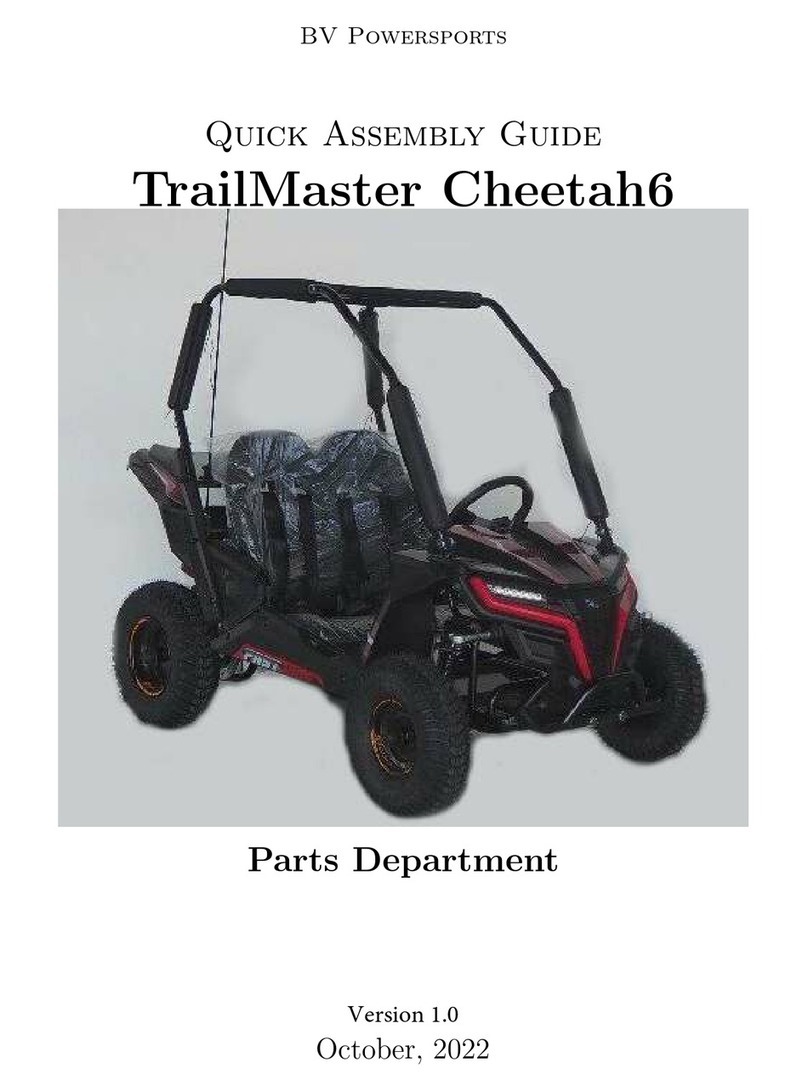
BV Powersports
BV Powersports TrailMaster Cheetah6 Quick assembly guide

HAUL MASTER
HAUL MASTER 95419 Assembly and operating instructions
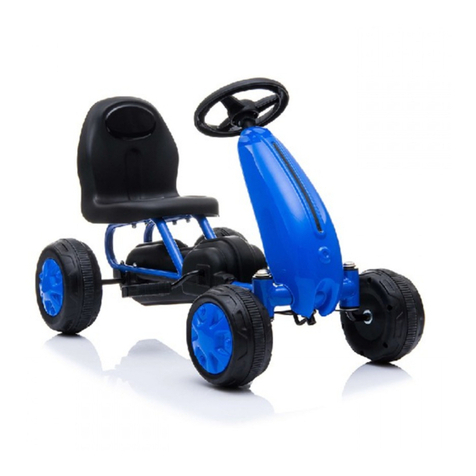
Moni
Moni BLAZE Operating instructions and assembly manual
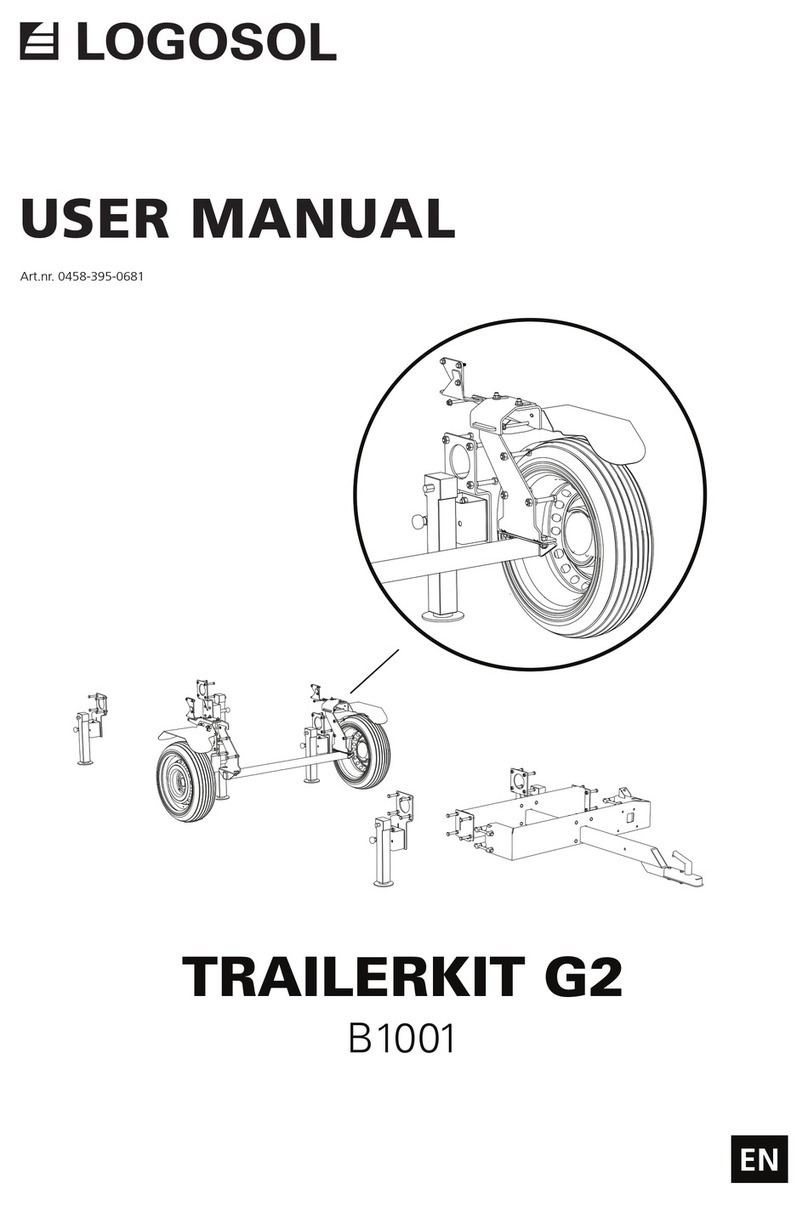
Logosol
Logosol TRAILERKIT G2 user manual

Wallenstein
Wallenstein LX100 manual

